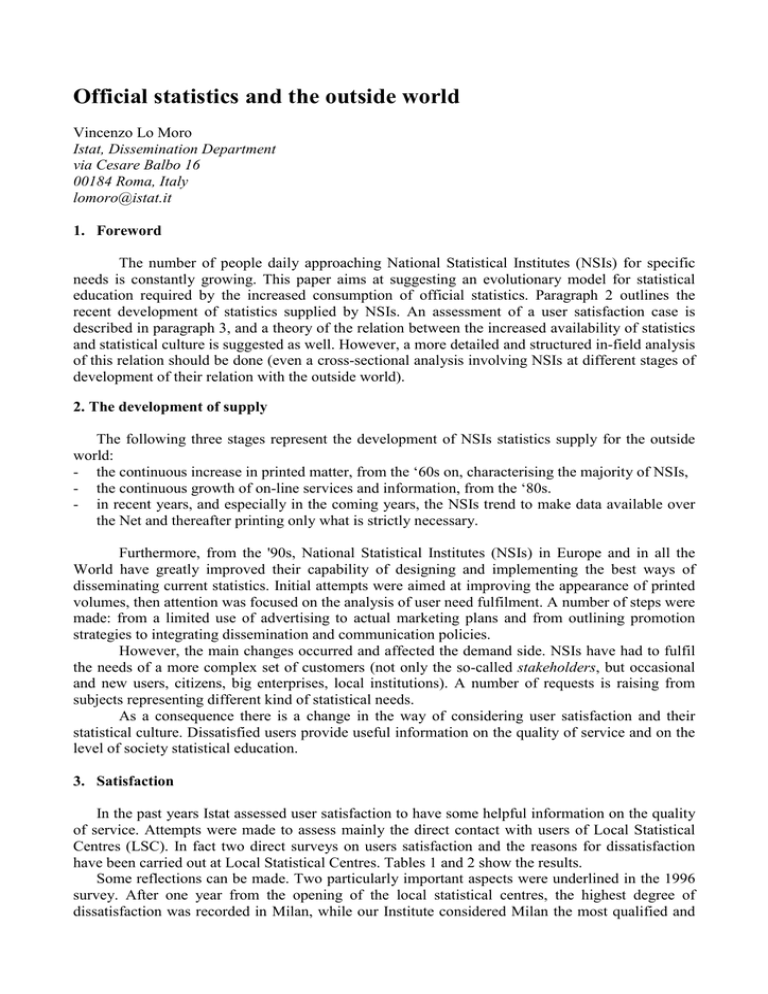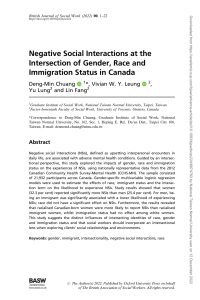Official statistics and the outside world.
advertisement

Official statistics and the outside world Vincenzo Lo Moro Istat, Dissemination Department via Cesare Balbo 16 00184 Roma, Italy lomoro@istat.it 1. Foreword The number of people daily approaching National Statistical Institutes (NSIs) for specific needs is constantly growing. This paper aims at suggesting an evolutionary model for statistical education required by the increased consumption of official statistics. Paragraph 2 outlines the recent development of statistics supplied by NSIs. An assessment of a user satisfaction case is described in paragraph 3, and a theory of the relation between the increased availability of statistics and statistical culture is suggested as well. However, a more detailed and structured in-field analysis of this relation should be done (even a cross-sectional analysis involving NSIs at different stages of development of their relation with the outside world). 2. The development of supply The following three stages represent the development of NSIs statistics supply for the outside world: - the continuous increase in printed matter, from the ‘60s on, characterising the majority of NSIs, - the continuous growth of on-line services and information, from the ‘80s. - in recent years, and especially in the coming years, the NSIs trend to make data available over the Net and thereafter printing only what is strictly necessary. Furthermore, from the '90s, National Statistical Institutes (NSIs) in Europe and in all the World have greatly improved their capability of designing and implementing the best ways of disseminating current statistics. Initial attempts were aimed at improving the appearance of printed volumes, then attention was focused on the analysis of user need fulfilment. A number of steps were made: from a limited use of advertising to actual marketing plans and from outlining promotion strategies to integrating dissemination and communication policies. However, the main changes occurred and affected the demand side. NSIs have had to fulfil the needs of a more complex set of customers (not only the so-called stakeholders, but occasional and new users, citizens, big enterprises, local institutions). A number of requests is raising from subjects representing different kind of statistical needs. As a consequence there is a change in the way of considering user satisfaction and their statistical culture. Dissatisfied users provide useful information on the quality of service and on the level of society statistical education. 3. Satisfaction In the past years Istat assessed user satisfaction to have some helpful information on the quality of service. Attempts were made to assess mainly the direct contact with users of Local Statistical Centres (LSC). In fact two direct surveys on users satisfaction and the reasons for dissatisfaction have been carried out at Local Statistical Centres. Tables 1 and 2 show the results. Some reflections can be made. Two particularly important aspects were underlined in the 1996 survey. After one year from the opening of the local statistical centres, the highest degree of dissatisfaction was recorded in Milan, while our Institute considered Milan the most qualified and 1 active centre. A phenomenon typically connected with renewal had occurred: user expectations exceeded the needs that could be actually fulfilled. 7DEOH6DWLVIDFWLRQLQ/RFDO6WDWLVWLFDO&HQWUHVPRQWKVIURPWKHLURSHQLQJHQGRI DISSATISFIED USERS % Italy Milan REASON FOR BEING DISSATISFIED 25 37 Not collected data Available formats other than requested Updating of data 35 15 50 7DEOH6DWLVIDFWLRQLQ/RFDO6WDWLVWLFDO&HQWUHV\HDUVIURPWKHLURSHQLQJ0DUFK ASSESSMENT OF SERVICE % Short of expectation Up to expectations Exceeding expectations 5 66 29 A more in-depth analysis of dissatisfaction shows that it was mainly dependent on inadequate information of the actual Institute supply. Not all requests could be fulfilled by the Institute, and problems arose concerning the quality of supply. An effective relation between demand and statistics supply required that what users could request from LSCs should be clearly defined. In other words, the Institute lacked effective communication with the outside world while users lacked adequate statistical education. A similar survey carried out in 1998 showed that this inconvenience has been quite overcome. The expectations of the majority of users are adequately fulfilled in all the LSCs. A marked share (29%) considers the service exceeding their expectations, and only 5% is dissatisfied. However, service improvement has not been completed yet, despite the positive results obtained. In fact answers fulfilling user expectations do not mean that the best service is being supplied. Expectations could even be particularly prudent, and it is still necessary to combine service improvement and communication with the outside world. As in Istat, remarkable surveys on satisfaction were carried out by the marketing department of CBS (N); they show that users are still exacting «professionals», despite marketing policies. The Danish Institute results show that users preferences are equally distributed between paper and online release. Old users are conservative, while new users are more flexible (ONS - UK) 4. Consumption and statistical education: an evolutionary model Let us assume that there is a direct relation between production and consumption of official statistics and between satisfaction and statistical education. The first relation is proved by the previous paragraph: production increases (or availability of production) because it is urged by stakeholders, and due to new technical tools, but it is also required by our society, which is more and more demanding concerning data and basic widespread information. The result is growing consumption, though sometimes unaware. 2 Satisfaction depends on education, at least when service is being improved. The importance of metadata or of supplementary information can be best appreciated if there is basic statistical education; and at the same time, if basic statistical education is more widespread, then more quality public statistical information is required. Figure 1 represents satisfaction and statistical education on one axis and the other is production and consumption. production, consumption E D C B A satisfaction education )LJXUH3URGXFWLRQFRQVXPSWLRQVDWLVIDFWLRQHGXFDWLRQ The line shows the progressive mutual adjustment of production-consumption, trying to achieve a more stable balance. “A” is the starting point, when production is stable and standard, and mainly printed; consumption is limited and specialised (through specific channels, such as libraries) or generic (inflation, employment, main indicators); satisfaction results from repetitive information, which is easily retrievable and comparable, even because techniques and definition are quite unchanging; users are seldom dissatisfied with quality and relevance of supplied information; statistical education is affected by reduced consumption and limited choice of information. Let us assume that a development of production occurs in A due to different factors which we can define as technological shock. Production processes (planning, data collection, checking, processing, dissemination) are assessed using techniques and methodologies showing the possibility of quality improvement. Moreover production is enlarged, new indicators are sought and new survey techniques are experimented. Users cautiously accept innovations. While some changes are welcomed, other create bewilderment. A greater number of users is approaching statistics, though they are often less qualified. Satisfaction decreases, despite the wider supply and B is the expected end of this first stage of development. C is achieved after a second, basic education shock. It represents mainly the increased awareness of old and new users. Awareness is a complex notion meaning a number of different things: understanding that the re-definition of series, formats, definitions, represents the search for a more adequate relation with real life and does not lead to detachment from history; understanding the importance of harmonisation; adjustment of expectations to a more adequate understanding of the pros and cons of public statistics (index numbers, rather than absolute levels; data rather than comments); reliability as a typical notion of statistics and not of accounting; the (partial) decline of printed matter which should be seen as a growth towards a more customised consumption. NSIs with their constant improvement of communication strategies have contributed to this achievement. The A-B-C development represents the empirical evidence of the analysis outlined in paragraph 2. We are now facing a new shock. Users are now becoming familiar with the possibilities of online products, but other changes are being introduced. In the current Italian scenario and all over the world (some countries are already fully involved) the relation between specific surveys and release of data will be probably lost. In the coming informational systems an input from different sources analysing the same field will be structured and the resulting output will be the system itself: the 3 Data Warehouse. Users could process and get the required information and large amount of data, complex links to metadata and new harmonised indices will be found. This systemic shock is very likely to produce the same bewilderment as the technological shock, though the starting education level is more favourable. D represents the new situation: growing consumption, new users which are more curious than specifically qualified. This is another occasion to improve the spread of public statistics. How would it be possible to reach E? Which education issues should be faced? How would it be possible to prevent another disappointing and excessive bewilderment? Three lines should be followed: a. Easy and clear conditions to access service. It is not only “user friendliness”, but transparency of access conditions and promises. Now, many data bases are “work in progress”, and not always there is a clear-cut division between free and on payment services, what is more, some data extraction requires specific skills. b. Effective organisation of metainformation. The association of different archives requires welldefined glossaries and nomenclatures. To educate users, adequate help systems should be provided, so that users would not disheartened. c. Possibility of easily processing autonomously data. Searching data should educate users and reduce the workload of NSIs 4. Conclusions Statistical education is based on learning, at school, techniques, approaches, and on becoming familiar with handling statistical data. However, statistical information becomes necessary only later in life, when official statistics data are required to work and to establish relations. The capability of fully using supply and of assessing the service depends on specific education and on other factors, such as permanent education, information and formation which should be organised and offered by NSIs with experts. These are the strategies to reduce the disappointment of conservative users facing improvement of supply and to help untrained new users. REFERENCES Dippo, C.S. e Tupek A.R., 1997, Creating a National Statistical Information Infrastructure, ISI Conference, 18-26 August, Istanbul. Kavaliunas, J. and Luppes, M., 1998, Measuring Customer Satisfaction: Progress and Best Practices of National Statistical Agencies, Joint IASS/IAOS Conference, September, Agualientes, Mexico, Proceedings Lo Moro, V. 1999, Issues in data dissemination, Manchester, CEIES seminar, January 28-29, Proceedings. Ottaviani, M.G.(ed.), 1996, Multimedia and new educational environments. Statisticians and expert exchange views. Rome, Italy, Proceedings Powell, P., 1997, Effective Presentation via User Consultation: the Use of Market Research to Guide Publications Improvements, ISI Conference, 18-26 August, Istanbul. Sundgren, B., 1996, Making Statistical Data More Available, International Statistical Review,64, 1. RESUME’ Face à l’amélioration de l’offre de statistiques officielles, on constate la manifestation de phénomènes contradictoires: d’une part, une plus grande satisfaction de la part de certains utilisateurs, d’autre part une certaine insatisfaction de la part d’autres utilisateurs (traditionnels et occasionnels). Afin que cette insatisfaction soit comprise et dépassée , il est nécessaire d’investir en éducation statistique et en communication externe, à effectuer sur la base d’une collaboration entre INS et experts du secteur. 4


